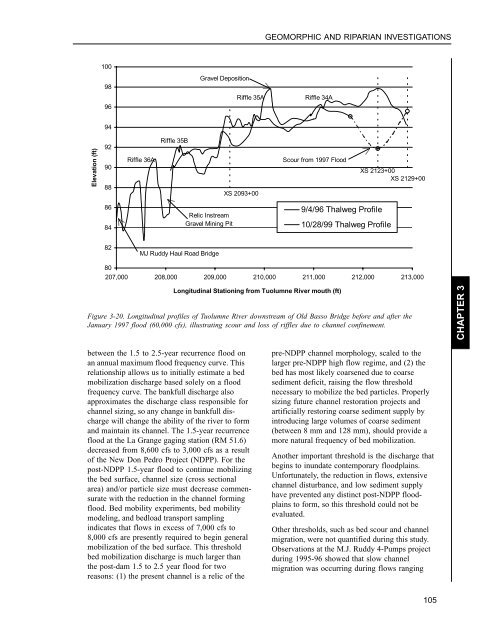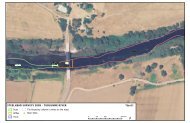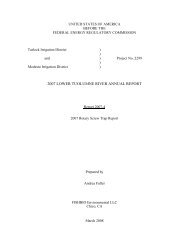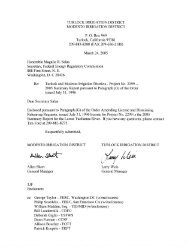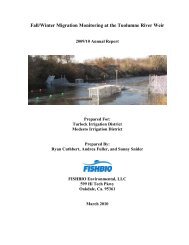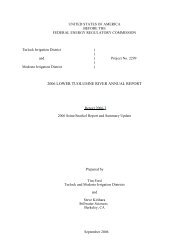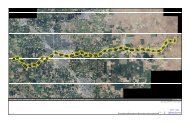Tuolumne River Report - U.S. Fish and Wildlife Service
Tuolumne River Report - U.S. Fish and Wildlife Service
Tuolumne River Report - U.S. Fish and Wildlife Service
You also want an ePaper? Increase the reach of your titles
YUMPU automatically turns print PDFs into web optimized ePapers that Google loves.
GEOMORPHIC AND RIPARIAN INVESTIGATIONS1009896Gravel DepositionRiffle 35ARiffle 34A94Elevation (ft)929088Riffle 36ARiffle 35BXS 2093+00Scour from 1997 FloodXS 2123+00XS 2129+008684Relic InstreamGravel Mining Pit9/4/96 Thalweg Profile10/28/99 Thalweg Profile82MJ Ruddy Haul Road Bridge80207,000 208,000 209,000 210,000 211,000 212,000 213,000Longitudinal Stationing from <strong>Tuolumne</strong> <strong>River</strong> mouth (ft)Figure 3-20. Longitudinal profiles of <strong>Tuolumne</strong> <strong>River</strong> downstream of Old Basso Bridge before <strong>and</strong> after theJanuary 1997 flood (60,000 cfs), illustrating scour <strong>and</strong> loss of riffles due to channel confinement.CHAPTER 3between the 1.5 to 2.5-year recurrence flood onan annual maximum flood frequency curve. Thisrelationship allows us to initially estimate a bedmobilization discharge based solely on a floodfrequency curve. The bankfull discharge alsoapproximates the discharge class responsible forchannel sizing, so any change in bankfull dischargewill change the ability of the river to form<strong>and</strong> maintain its channel. The 1.5-year recurrenceflood at the La Grange gaging station (RM 51.6)decreased from 8,600 cfs to 3,000 cfs as a resultof the New Don Pedro Project (NDPP). For thepost-NDPP 1.5-year flood to continue mobilizingthe bed surface, channel size (cross sectionalarea) <strong>and</strong>/or particle size must decrease commensuratewith the reduction in the channel formingflood. Bed mobility experiments, bed mobilitymodeling, <strong>and</strong> bedload transport samplingindicates that flows in excess of 7,000 cfs to8,000 cfs are presently required to begin generalmobilization of the bed surface. This thresholdbed mobilization discharge is much larger thanthe post-dam 1.5 to 2.5 year flood for tworeasons: (1) the present channel is a relic of thepre-NDPP channel morphology, scaled to thelarger pre-NDPP high flow regime, <strong>and</strong> (2) thebed has most likely coarsened due to coarsesediment deficit, raising the flow thresholdnecessary to mobilize the bed particles. Properlysizing future channel restoration projects <strong>and</strong>artificially restoring coarse sediment supply byintroducing large volumes of coarse sediment(between 8 mm <strong>and</strong> 128 mm), should provide amore natural frequency of bed mobilization.Another important threshold is the discharge thatbegins to inundate contemporary floodplains.Unfortunately, the reduction in flows, extensivechannel disturbance, <strong>and</strong> low sediment supplyhave prevented any distinct post-NDPP floodplainsto form, so this threshold could not beevaluated.Other thresholds, such as bed scour <strong>and</strong> channelmigration, were not quantified during this study.Observations at the M.J. Ruddy 4-Pumps projectduring 1995-96 showed that slow channelmigration was occurring during flows ranging105


